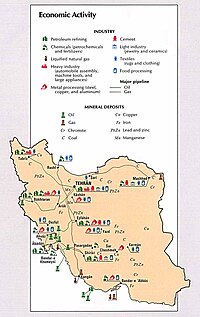
Mining in Iran is still under development, yet the country is one of the most important mineral producers in the world, ranked among 15 major mineral-rich countries,[1] holding some 68 types of minerals, 37 billion tonnes of proven reserves and more than 57 billion tonnes of potential reserves worth $770 billion in 2014.[2][3] Mineral production contributes only 0.6 percent to the country's GDP.[citation needed] Add other mining-related industries and this figure increases to just four percent (2005). Many factors have contributed to this, namely lack of suitable infrastructure, legal barriers, exploration difficulties, and government control.
The most important mines in Iran include coal, metallic minerals, sand and gravel, chemical minerals and salt. Khorasan has the most operating mines in Iran. Other large deposits which mostly remain underdeveloped are zinc (the world's largest), copper (world's ninth largest reserves in 2011, according to the managing director of National Iranian Copper Industries Company), iron (the world's 12th largest in 2013 according to the US Geological Survey),[4] uranium (the world's tenth largest) and lead (world's eleventh largest).[5][6][7][8][9] Iran with roughly 1% of the world's population holds more than 7% of the world's total mineral reserves.[10]
In 2019, the country was the 2nd largest world producer of gypsum;[11] the 8th largest world producer of molybdenum;[12] the world's 8th largest producer of antimony;[13] the 11th largest world producer of iron ore;[14] the 18th largest world producer of sulfur,[15] in addition to being the 21st largest worldwide producer of salt.[16] It was the 13th largest producer in the world of uranium in 2018.[17]
- ^ "Mining in Iran – CountryMine". InfoMine. Archived from the original on 2 November 2011. Retrieved 18 October 2011.
- ^ "Iran's Power in Power Plants". Archived from the original on 15 May 2009. Retrieved 17 November 2019.
- ^ "دسترسی غیر مجاز". Archived from the original on 20 June 2015. Retrieved 15 September 2014.
- ^ US Geological Survey, Mineral commodity summary: iron ore Archived 11 August 2013 at the Wayback Machine, 2013.
- ^ "'Iran's copper output will increase 3.5-fold' - Tehran Times". Archived from the original on 24 November 2011. Retrieved 28 November 2011.
- ^ "Archived copy". Archived from the original on 21 October 2008. Retrieved 15 March 2010.
{{cite web}}: CS1 maint: archived copy as title (link) CS1 maint: unfit URL (link) - ^ "Iran's Economy". Iraniantrade.org. Archived from the original on 7 October 2011. Retrieved 18 October 2011.
- ^ "Archived copy". Archived from the original on 5 March 2016. Retrieved 16 March 2010.
{{cite web}}: CS1 maint: archived copy as title (link) - ^ "advantageaustria.org – official business portal Austria (B2B, import, export, Austrian products, investment)" (PDF). Austriantrade.org. Archived from the original (PDF) on 28 August 2017. Retrieved 18 October 2011.
- ^ "Iran's Islamic Revolution and Its Future – Harvard – Belfer Center for Science and International Affairs". Belfercenter.ksg.harvard.edu. Archived from the original on 2 August 2011. Retrieved 18 October 2011.
- ^ USGS Gypsum Production Statistics
- ^ USGS Molybdenum Production Statistics
- ^ USGS Antimony Production Statistics
- ^ USGS Iron Ore Production Statistics
- ^ USGS Sulfur Production Statistics
- ^ USGS Salt Production Statistics
- ^ World Uranium Mining